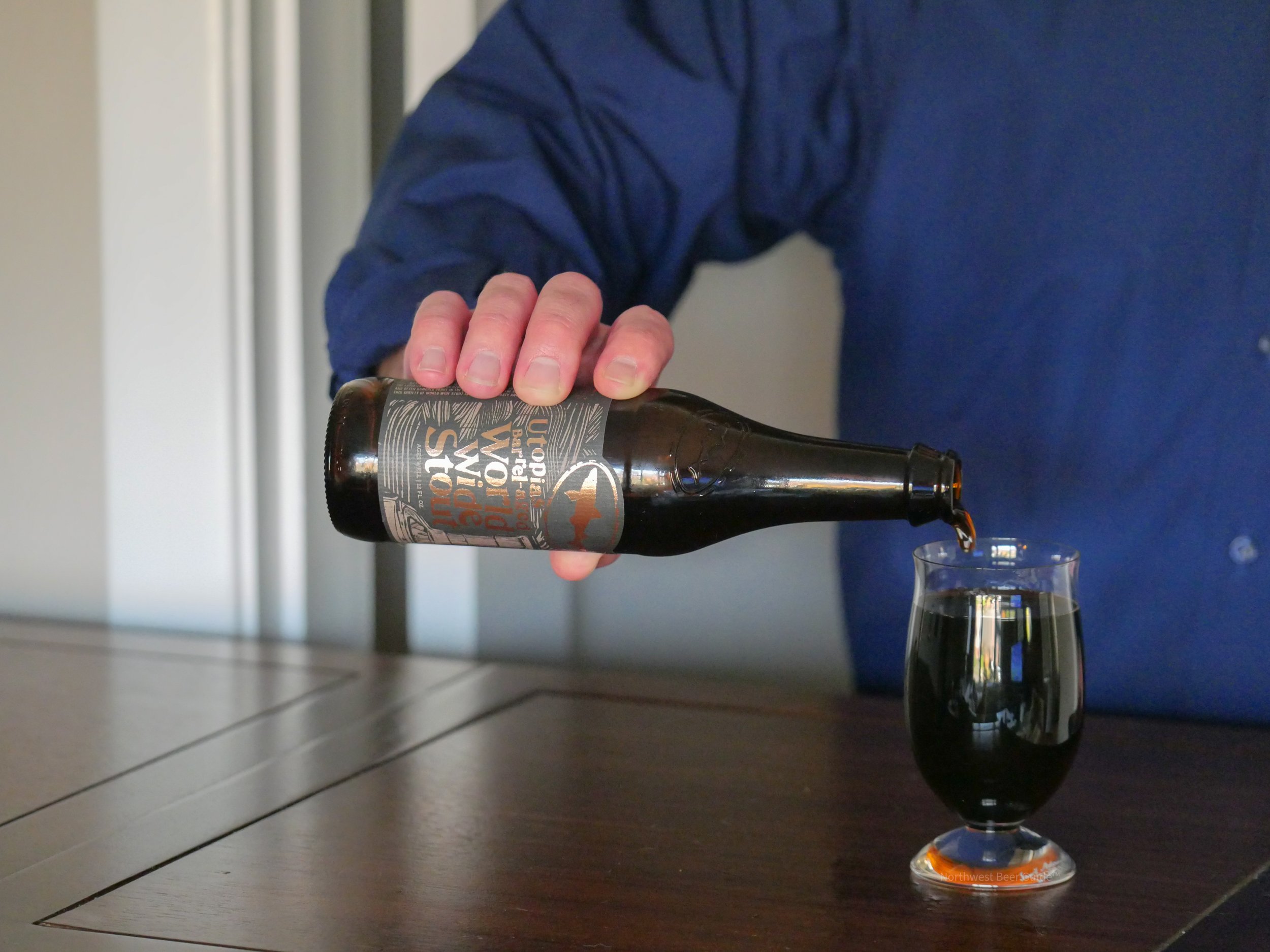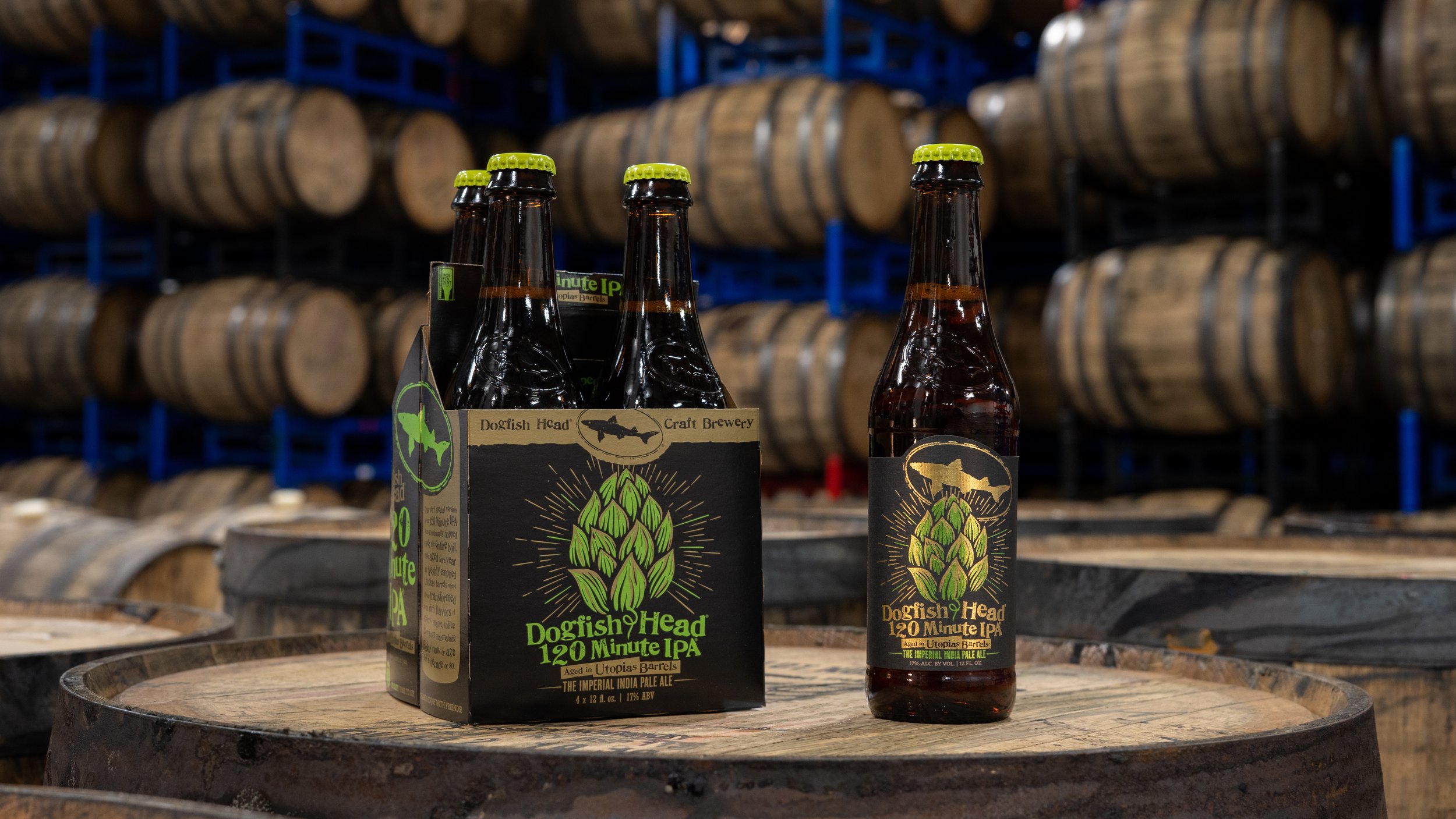Learn more about two beers, made from the same barrels, in Utopias and Utopias Barrel-aged World Wide Stout.

Long before the stainless-steel fermenters, there was the wooden barrel.
A brewer's best-friend, the wooden barrel was often used to age recently brewed ales or lagers. But it was also the means for transportation and delivery of said ales and lagers, at pubs, inn, and taverns throughout the world. Nowadays, wooden barrels remain primarily associated with creating spontaneous, wild, or secondary fermented beers. If you need further proof, just walk the aisles of your nearby grocery store or specialty bottle shop, to see beers with names like Lambic, Foedere, or, yeah, barrel-aged.
These beers, at one point, were conceived, brewed, aged in a fermenter or aged in a barrel, aided by yeast, possibly adjuncts (like fruit, herbs or spices), and possibly in a barrel-previously used to make spirits or wine. Now if all of this is a novelty and you’ve heard of wine barrel-aged this, or bourbon barrel-aged that, then when was the last time you heard about a beer, which was aged in wooden barrels, previously used to make an even stronger beer? If you’ve not heard of this, then you’ve not heard of Utopias barrel-aged World Wide Stout, made by the dedicated brewers of Dogfish Head Craft Brewery in Milton, Delaware. Oh, you’ve not heard of Utopias?
So what’s a Utopias anyways?!
Made by the brewers of iconic Boston brewery, Boston Beer Company’s Samuel Adams, Utopias was released in 2002, proving that beer isn't just for backyard barbecues, ball games, or tailgates. With an ABV (alcohol by volume) averaging some 28% (or 56 proof), Utopias is not only one of the highest ABV beers out there but also one of the most expensive at nearly $250. Showcased in a 25.6 fluid ounce bottle, surrounded by a copper jacket and in the shape of a copper kettle brewery, Utopias remains a hard to find and still talked about beer.
Yeah, despite non-beer drinkers comparing it to port or sherry, this beer isn’t produced in stainless-steel fermenters, but is instead aged in wood barrels, many of which were used to produce everything from spirits (like bourbon, cognac, rum, aquavit, whiskey, or whisky) but also in port and, yeah, sherry barrels. The result is a beer that will not only make you recall your last glass of port or sherry but also a short stack of pancakes on a warm, sunlit morning. To learn more about the process, here’s Samuel Adams.
Each release we hand-select single-use bourbon casks from our friends at the award-winning Buffalo Trace Distillery. The beer then ages even longer in a variety of spirit barrels including Bourbon, Wine, Port, and more, each gifting their unique flavors and history to Utopias. For 2021, we used a combination of 86 different barrels. We began barrel-aging beer in 1993 with the Triple Bock. Today, our techniques have led to the lunatic fringe of brewing, one of the oldest, strongest, most extreme beers in the world.
Some of the beer in this extreme reserve spends up to 30 years in bourbon barrels, which makes for a pretty tough customer. It’s inefficient, but the long road to your glass means Utopias has earned a complex character for a drinking experience above the ordinary.
Utopias is a true community effort. Our head brewers want it to pass through every Sam Adams brewery. We brew, age, and blend in various locations across the country, before a time-intensive hand-bottling process where we personally make sure each bottle of Utopias is given special attention.
Brewed with multiple yeast strains, including those used in champagne, and designed to sustain itself in the highest of alcoholic environments, Utopias remains a beer despite the ABV. But it’s not just the use of high abv-tolerant yeast, or the barrels from which it’s aged in, but also the use of a blending program that takes full advantage of Samuel Adams’ library of wood-aged beers, some going back 30 years.
Using a similar process, distillers, and vintners employ, the brewers and sensory experts at Samuel Adams, measure volumes of aged Utopias from various barrels and various years (even decades). Taking careful notes for aroma, flavor, mouthfeel, and finish, and measuring volumes to take full advantage of a perceived strength or flaw, the staff eventually settle on a ratio, resulting in that year’s Utopias. So, to better understand what makes Utopias still talked about, after all these years, we sought out a bottle which just turned out to be 2021’s edition aged with cherries. And our thoughts? Well, read below.
Utopias 2021, our thoughts.
First off, Utopias remains as it has in the past, a still or an ale with no visible carbonation. Because of this, you get little in the way of whipped, foamy caps on top. What remains in the glass is burgundy, but clear. While the lack of carbonation might be a turnoff, it’s important to recognize that this still beer will not change in characteristics nor will it take on carbonation.
Swirling there are notes of maple, vanilla, and some dark fruit.
Sipping, you get upfront notes of maple, a hint of apricot, dark cherries, along with notes of oak, maple, and vanilla. Overall, there is a definite strong mouthfeel, and a lingering alcoholic burn.
If we were to associate this with a moment during the day or night, we’d probably pair it with an energetic fireplace, after a three-course meal, accompanied by a black forest cake, or maybe while relaxing in the living room as a gentle snow falls against the night sky. But we haven’t even gotten to what this beer does to Dogfish Head’s iconic World Wide Stout.
World Wide Stout, one of the first extreme beers.
Released in 1999, World Wide Stout was Dogfish Head Craft Brewery’s founder Sam Calagione, shot across the bow to conventional thinking that beer had to be light, sessionable, or under 10%.
Brewed with copious amounts of barley, World Wide Stout remains one of the few imperial stouts which challenge imbibers' patience, to put a few bottles away in their closets, basements, or buried in the backyard. Although the results will never replicate that first sip, from that year’s release, World Wide Stout is one of those beers that will never be retired by Dogfish Head’s brewery staff. What’s more the brewery, like Samuel Adams, has aged this beer in various wooden barrels.
Besides the usual bourbon barrels, World Wide Stout by Dogfish Head has aged, among other things, in previous use oak-aged vanilla bean barrels.
What’s even more remarkable is the beer’s ABV fluctuates from year to year, with the lowest being around 15% and the high being around the 20% range.
For more on this beer, here’s a 10-year old review by the founder himself, Sam Calagione.
Obviously, your individual sensory notes will vary from year to year and from batch to batch, but the importance is what the beer was before it takes that next leap, into previous use Utopias barrels.
World Wide Stout becomes Utopias Barrel-aged World Wide Stout
Starting with Utopias barrels that were only recently emptied, Dogfish Head takes ownership of these wet barrels (meaning they still have Utopias), before receiving large volumes of World Wide Stout. After being filled to the brim, they are capped, remaining (mostly) untouched for some 7 months. During this time, the brewers of Dogfish Head will take occasional samples from each barrel, evaluating the characteristics gained from the Utopias barrels and how this interplays with Dogfish Head’s World Wide Stout. Once the beer is deemed ready, they empty these barrels, emptying them into 12-ounce bottles, each kissed with the Dogfish Head’s logo, a shark, and the words World Wide Stout, in gold lettering. But how does it taste?
Utopias Barrel-aged World Wide Stout, our thoughts.
With its iconic, neon, yellow-green cap, World Wide Stout initially pours with a vigorous head, before finishing still, almost matching the iconic stillness found in Utopias by Samuel Adams.
Dark as pitch and with little to no light escaping, there is a soothing calm about how this beer’s surface. Obviously, we would prefer an imperial stout to have a fogbank of khaki-white head, but the lack of strong carbonation isn’t a negative as we dive deeper.
Swirling, one recalls aromatic notes of dark roasted coffee, hints of baking chocolate.
Sipping, there are upfront notes of dark chocolate, sweet dark fruit, before vanilla and honeycomb make an appearance. Overall Utopias barrel-aged World Wide Stout, has a medium to strong mouthfeel, a strong (like 17.7% ABV) alcoholic warmth, and a lingering finish akin to consuming a black forest cake, with the cherry replaced by something more alcoholic.
Final thoughts, the relationship between Utopias, their previous use barrels, and Utopias Barrel-aged World Wide Stout
When enjoying these side by side, there is a definite marriage of maple, dark fruit, and notes recovered from the previous use barrels, first used to age Utopias and then World Wide Stout. Overall, this is a fun project between two perennial breweries in Sam Calagione’s Dogfish Head and Jim Koch’s Samuel Adams.
At 17.7% ABV (alcohol by volume), you might be lucky to come across a 12-ounce bottle or four-pack of Utopias barrel-aged World Wide Stout, wherever you find Dogfish Head’s regular World Wide Stout. While at 28% ABV, Samuel Adams’ Utopias 2021, aged on Balaton Cherries from Michigan and in Sauternes French Oak Wine casks, is available at select retailers throughout the country.
If you chance upon both, one might consider your own pairing session, preferably with a few friends, and see if you can find the unique relationship between two beers, Utopias and Utopia’s Barrel-aged World Wide Stout, which share a relationship spread across many barrels.










